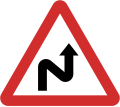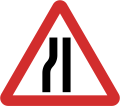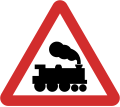B1: Crossroads with a minor ahead
B2: Crossroad with a major road ahead
B3: Side road on the left ahead
B3: Side road on the right ahead
B4: Staggered junction ahead
B4: Staggered junction ahead
B5: T-junction ahead
B6: Y-junction ahead
B7: Traffic merges from left
B8: Traffic merges onto carriageway
B9: Roundabout ahead
B10: Sharp curve to the left ahead
B10: Sharp curve to the right ahead
B11: Hairpin curve to the left ahead
B11: Hairpin curve to the right ahead
B12: Double curve ahead first to the left
B12: Double curve ahead first to the right
B13: Sharp bend to the left
B13: Sharp bend to the right
B13: Sharp bend to the left
B13: Sharp bend to the right
B14: Road narrows on both sides
B15: Road narrows on left sides
B15: Road narrows on right sides
B16: Dual carriageway ends ahead
B17: Traffic signals ahead
B18: Steep hill downwards
B19: Steep hill upwards
B20: Height limit ahead
B21: Two-way traffic straight ahead
B22: Two-way traffic crosses one way road
B23: Pedestrian crossing ahead
B24: Pedestrians in road ahead
B25: Children ahead
B26: Cattle ahead
B27: Deer ahead
B28: Unprotected quayside or riverbank ahead
B29: Uneven road
B30: Slippery road surface ahead
B31: Road hump
B32: Low-flying aircraft ahead
B33: Falling rocks
B33: Falling rocks
B34: Dangerous dip
B35: Narrow bridge ahead
B36: Other danger ahead
B37: Checkpoint ahead
B38: Roadworks ahead
B39: Loose chippings
B41: Railway level crossing ahead with gate or barrier
B40: Railway level crossing ahead without gate or barrier
B42: Diversion ahead
B43: Dangerous obstruction (Verges)
B43: Dangerous obstruction (verges)
B44: Dangerous obstruction (Central reservation)
B45: T Junction
B46: Sharp bend
B46: Sharp bend
B47: Diversion
B47: Diversion





























































































































